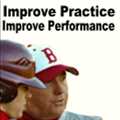Does
It Help, Does It Hurt? A Look At Training For Baseball And Common Shoulder Injuries
By Ethan Bowlin
Is your training increasing or decreasing your risk of injury? Our goal is to function at
the highest level possible while reducing the risk of injury. Baseball is a sport that involves strength, speed, endurance,
flexibility, and mobility to name a few. What I have been seeing with baseball players from little league, early adolescence
into their adult lives is the widely accepted notion that to become a better athlete you have to train for form, not so much
function. What is the difference?
Form is what can be termed bodybuilding, building the body with focus on big muscles or prime
movers of the body. The chest, shoulders, abdominals, arms and quads, also known as mirror muscles, what we can see in the
mirror, are most commonly developed using machines and free weights. Bench press, crunches, biceps curls and knee extensions
are the exercises of choice. What is wrong with that, you may say? I thought that to be involved in athletics, I have to become
stronger and condition the body for that sport? Yes and no. Let me explain, let’s look at function.
Function is what is useful, how the body is utilized throughout different planes of movement
for a desired action. Baseball for example, involves throwing, hitting and running and must deal with forces that cause rotation,
forces that distract a joint during acceleration, and forces that must be decelerated, stabilized and transferred to produce
the desired action. So you ask, I thought that building my muscles stronger would accomplish that? When we focus on form or
bodybuilding only, you are creating an unbalanced environment.
Let’s take look at one of the most problematic issues regarding baseball players, shoulder
injuries. When an athlete throws a baseball, force is generated from the lower body and transferred through the core into
the upper body through the shoulder, elbow and wrist providing the “speed” of the baseball. However, the force
does not stop there. Once the ball is released, that force does not disappear, it must be decelerated back through the wrist,
elbow, shoulder, upper body, core and lower body. Simply stated, what you speed up, you must slow down.
The shoulder is the most mobile joint in the body, however, what we gain in mobility we sacrifice
stability. Picture the shoulder as a ball sitting on a plate, very mobile but not very stable. For the shoulder, or any joint
for that matter, must be stable before moving. Stability of the shoulder is heavily reliant on the rotator cuff muscles. The
rotator cuff muscles originate from the shoulder blade and its goal is to keep the ball centered on the plate so the big muscles
can produce the accelerating, decelerating and rotational forces while throwing. Muscles surrounding the shoulder blade that
provide stability for the shoulder joint include the lower trapezius, serratus anterior and rhomboid muscles. All these muscles
not only provide support for the shoulder but also are crucial in holding your posture.
Weakness in these muscles and focusing on strength training for the chest, arms and abdominals
will create an imbalance between the front and back of the shoulder girdle (upper body) possibly creating a rounded upper
back, forward head appearance (slouching). This imbalance places the upper back muscles in a lengthened position, which will
create greater stress on the rotator cuff during deceleration phase (follow through) of throwing and altered throwing mechanics.
Many times it can manifest as soreness and pain in the shoulder, down into the upper arm, elbow and forearm. So how do I avoid
this? Build your body like building a house. You wouldn’t start with the roof and windows before having a solid foundation.
Then don’t just jump into strength training, start with a strong stable foundation and proper alignment before packing
on the muscle!
First use a foam roller to loosen tight muscles and stretch the muscles around your shoulder
for optimal range of motion (For more information the foam roller, look at Relieve Pain with Foam). Stretching the muscles
in the front (chest, shoulders, and internal rotators) and strengthening the muscles in the back (lower trapezius, rhomboids,
and external rotators) will help to balance your shoulder girdle. Next, because we transfer force from the lower body to the
upper body while throwing and vice versa we target core stability and strength. The core involves more than just your abdominals
and low back; it includes the deep muscles along your spine down through your pelvis and hips. Most people think of core exercises
as movements such as crunches, twists and back extensions to name a few, however that is only one part of it. Core exercises
can be split into stabilizing and movement exercises. When we attempt to develop core strength without core stability, we
are forcing our bodies to rely on the prime movers, such as the chest, abdominals and shoulders to do the stabilizing. We
must be stable before we can move; otherwise energy is wasted while throwing, running and hitting, all baseball movements.
For a small range of exercises with a variety of uses from improving posture to sport specific exercises for throwing go to
Does It Help Does It Hurt on the fuel page at performance4life.com
Ethan Bowlin is a fitness professional and co-founder of Performance 4 Life. Ethan coaches baseball and
specializes in rehabilitation and strength and conditioning and can be reached at
ebowlin@performance4life.com
Article Source:
http://EzineArticles.com/?expert=Ethan_Bowlin

